Bzzzz, there's a new crop of beekeepers preparing for their bees this spring
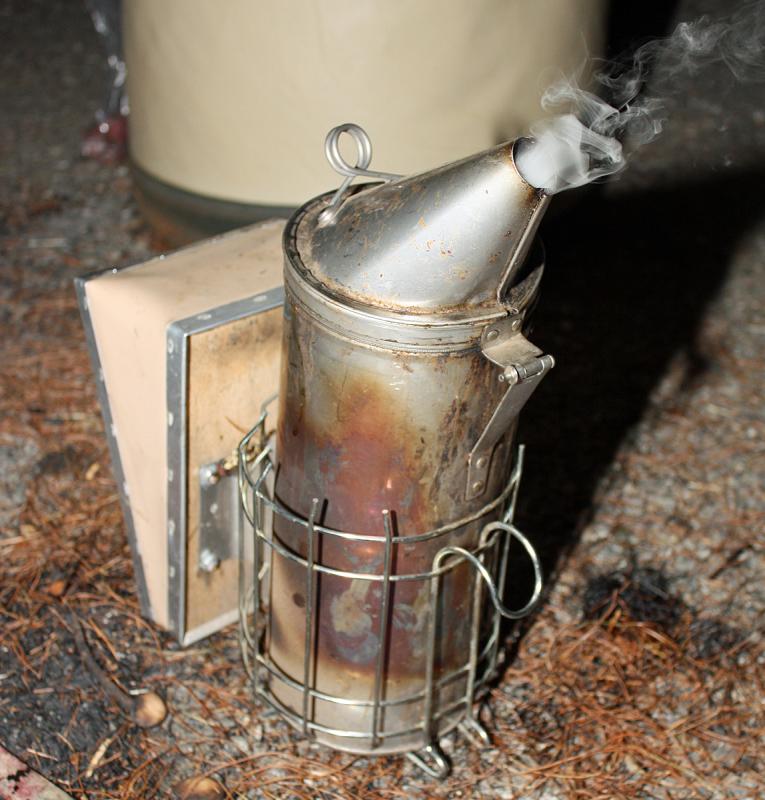 Slow, steady wisps of smoke emanate from an adequately fueled and ignited beehive smoker during the first class of the 2013 Knox-Lincoln County Beekeepers club bee school March 5. (Photo by Holly S. Edwards)
Slow, steady wisps of smoke emanate from an adequately fueled and ignited beehive smoker during the first class of the 2013 Knox-Lincoln County Beekeepers club bee school March 5. (Photo by Holly S. Edwards)
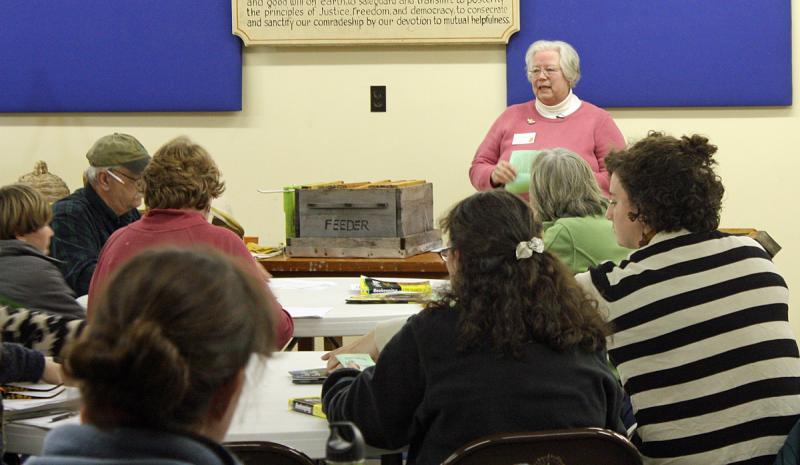 Jean Vose at the 2013 Bee School. (Photo by Holly S. Edwards)
Jean Vose at the 2013 Bee School. (Photo by Holly S. Edwards)
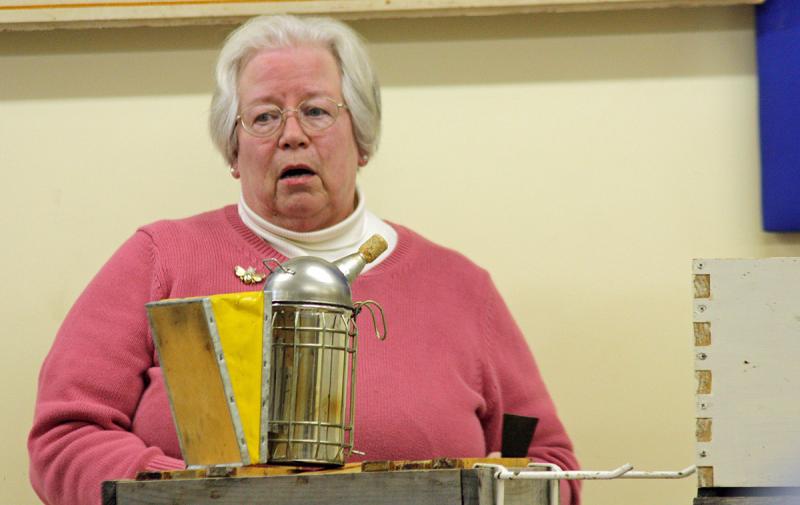 Jean Vose and a smoker.
Jean Vose and a smoker.
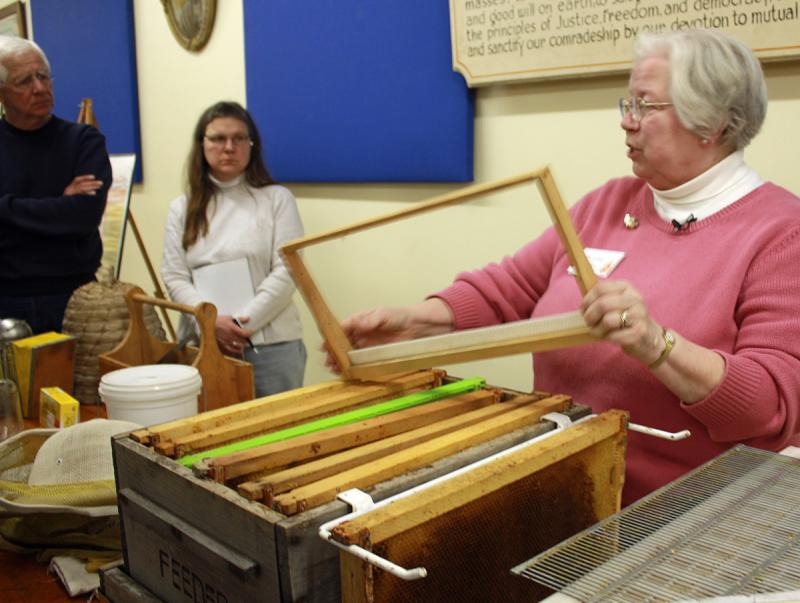 Jean Vose shows students a foundationless frame, on which honeybees will build the entire foundation of honeycomb with beeswax. (Photo by Holly S. Edwards)
Jean Vose shows students a foundationless frame, on which honeybees will build the entire foundation of honeycomb with beeswax. (Photo by Holly S. Edwards)
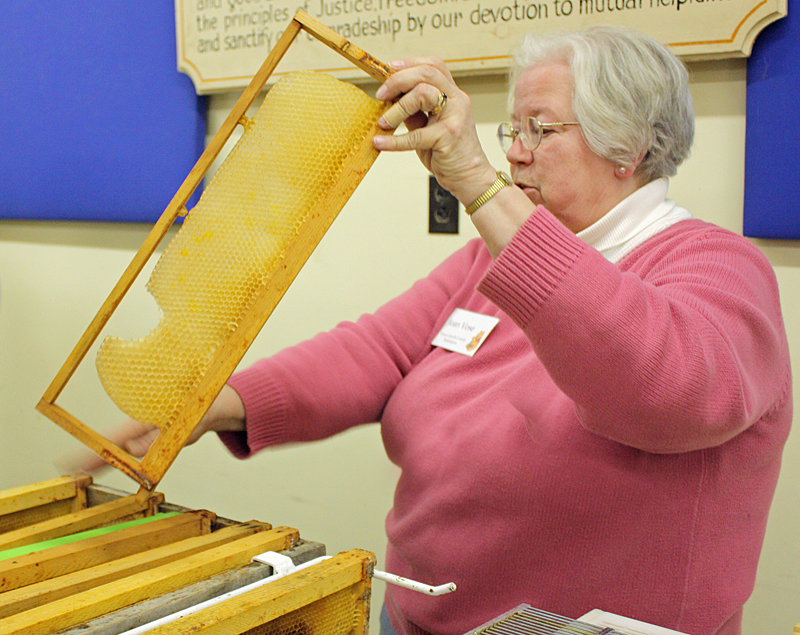 Jean Vose displays a foundationless frame on which honeybees have drawn the comb from top to bottom. (Photo by Holly S. Edwards)
Jean Vose displays a foundationless frame on which honeybees have drawn the comb from top to bottom. (Photo by Holly S. Edwards)
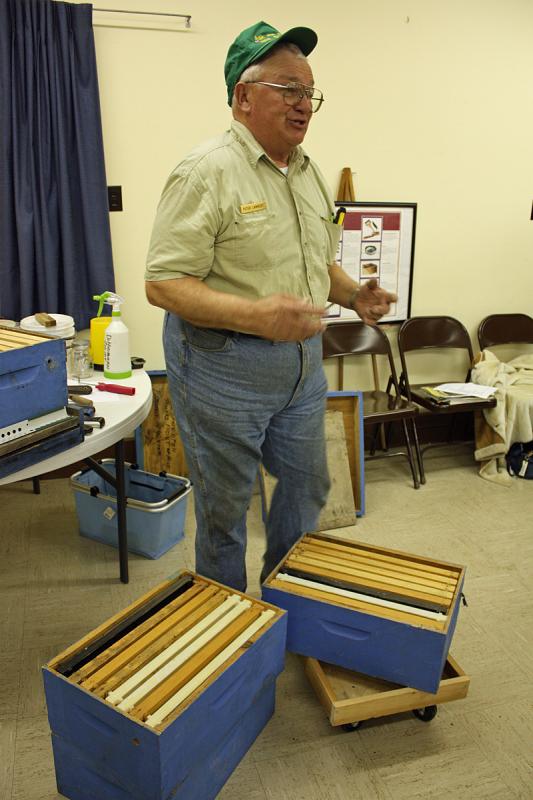 Peter Lammert shows what a hive box looks like with its 10 frames inside. (Photo by Holly S. Edwards)
Peter Lammert shows what a hive box looks like with its 10 frames inside. (Photo by Holly S. Edwards)
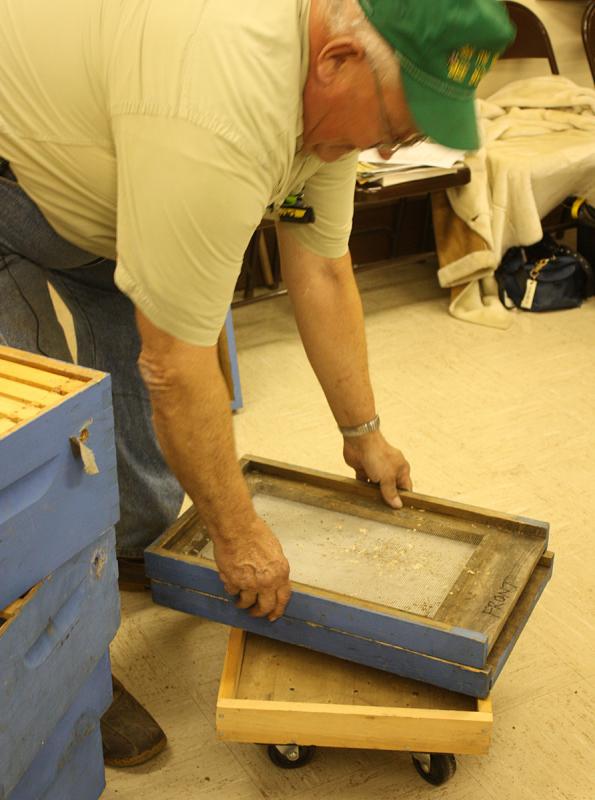 Peter Lammert and a screen bottom board, though which detritus and mites fell down onto for disposal. (Photo by Holly S. Edwards)
Peter Lammert and a screen bottom board, though which detritus and mites fell down onto for disposal. (Photo by Holly S. Edwards)
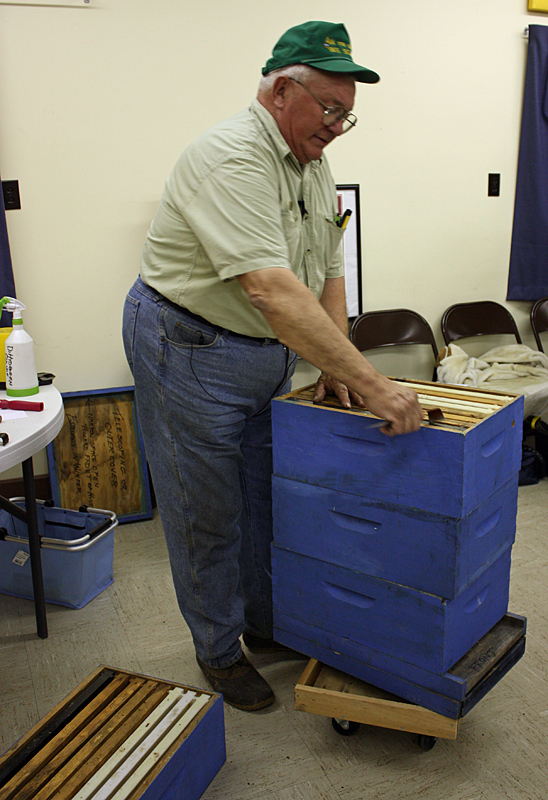 Peter Lammert stacks three medium hive boxes and shows how a tool can be used to pry apart frames stuck together by the bees with propolis. (Photo by Holly S. Edwards)
Peter Lammert stacks three medium hive boxes and shows how a tool can be used to pry apart frames stuck together by the bees with propolis. (Photo by Holly S. Edwards)
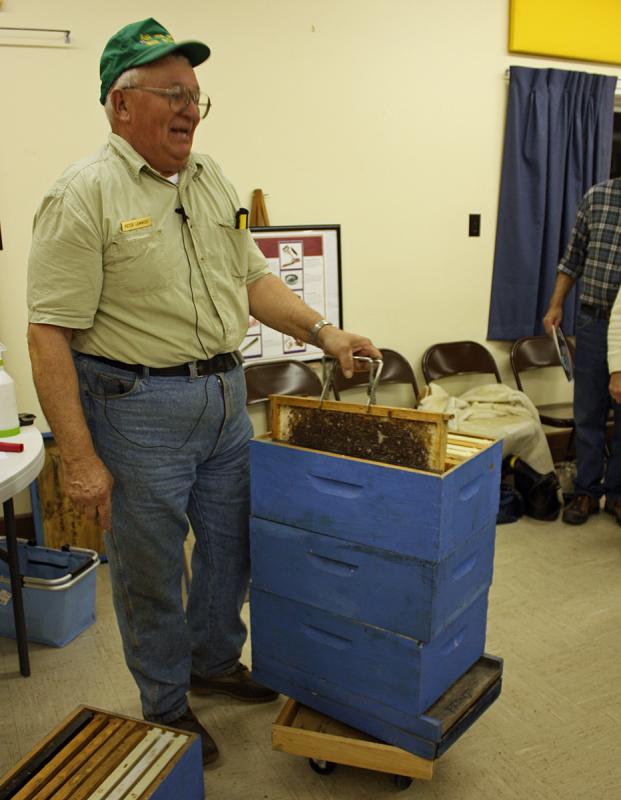 Peter Lammert uses another tool to lift out frames. (Photo by Holly S. Edwards)
Peter Lammert uses another tool to lift out frames. (Photo by Holly S. Edwards)
 Peter Lammert with a beehive that's made of four mediums with an inner cover. One shallow box, called a honey super, is added when the rest of the hive is filled and that's the honey the beekeeper gets to keep. (Photo by Holly S. Edwards)
Peter Lammert with a beehive that's made of four mediums with an inner cover. One shallow box, called a honey super, is added when the rest of the hive is filled and that's the honey the beekeeper gets to keep. (Photo by Holly S. Edwards)
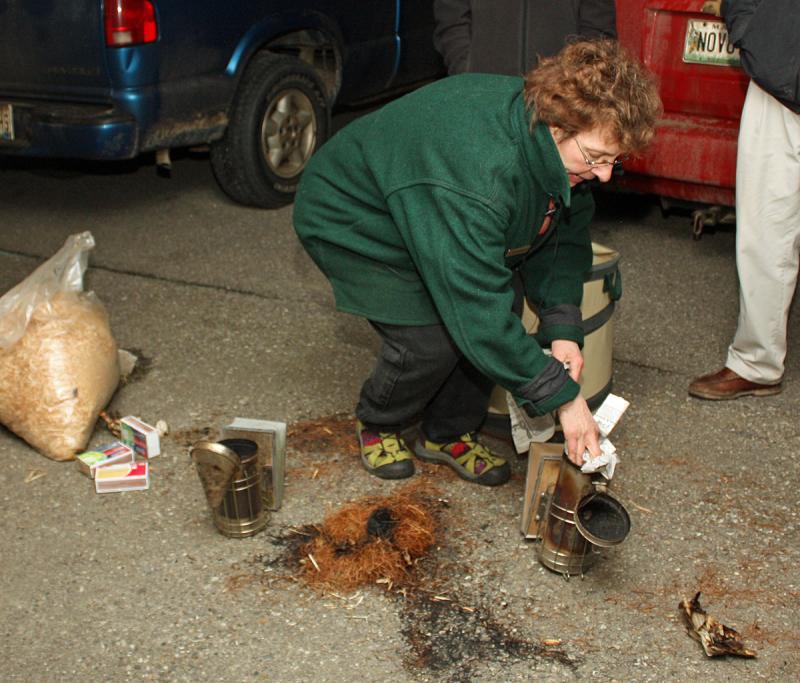 Jane Dunston fills a smoker with tinder material, which can include pine needles, shavings, burlap and grass, among other things. (Photo by Holly S. Edwards)
Jane Dunston fills a smoker with tinder material, which can include pine needles, shavings, burlap and grass, among other things. (Photo by Holly S. Edwards)
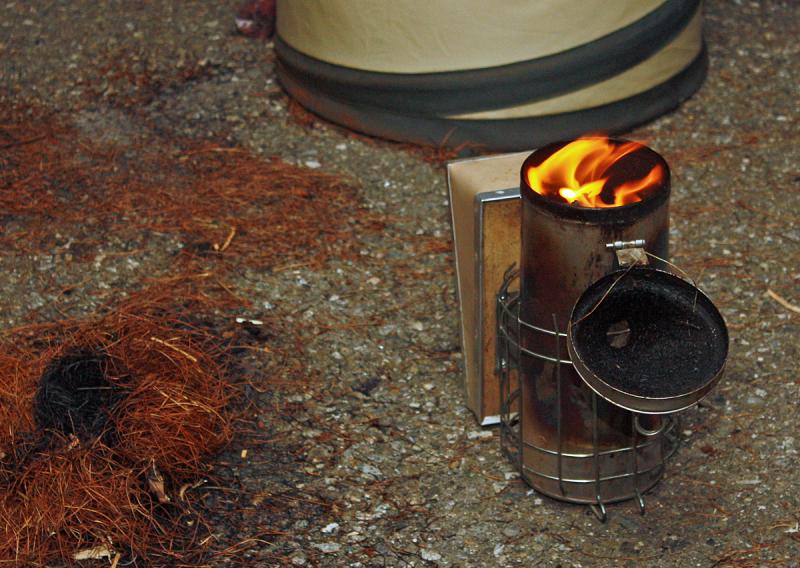 With some flame, it's time to jam more stuff on top so it smolders and smokes, not burns and flames. (Photo by Holly S. Edwards)
With some flame, it's time to jam more stuff on top so it smolders and smokes, not burns and flames. (Photo by Holly S. Edwards)
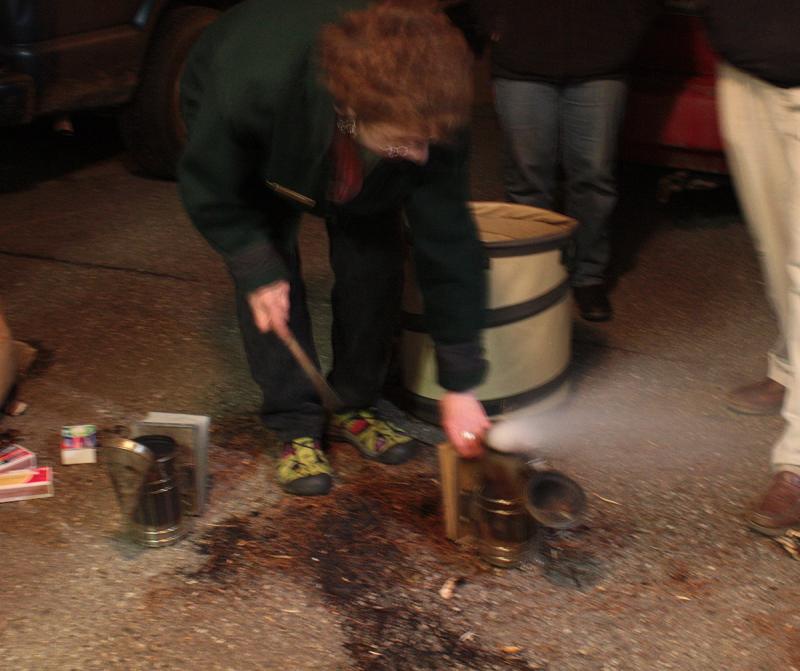 A few puffs of the bellows and we have smoke. (Photo by Holly S. Edwards)
A few puffs of the bellows and we have smoke. (Photo by Holly S. Edwards)
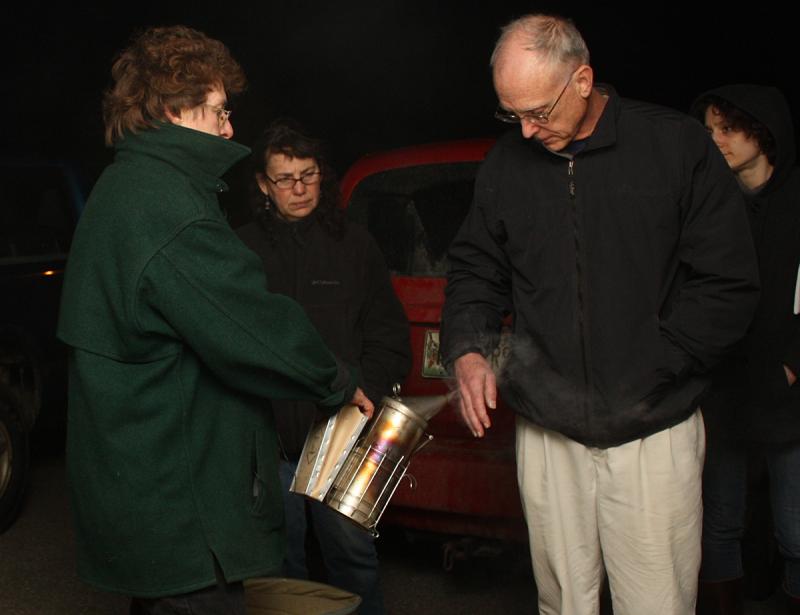 Proving to the students that it's important to make cool smoke, not hot smoke. (Photo by Holly S. Edwards)
Proving to the students that it's important to make cool smoke, not hot smoke. (Photo by Holly S. Edwards)
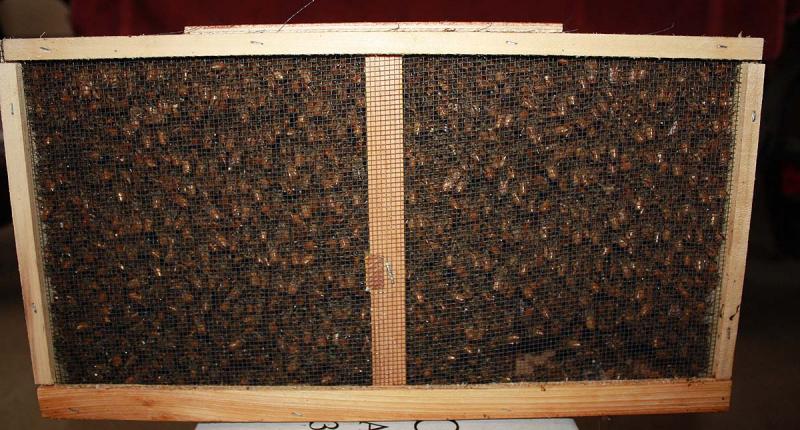 A package of about 12,000-15,000 bees before installation at Jean Vose's beehives in Nobleboro April 20. (Photo by Holly S. Edwards)
A package of about 12,000-15,000 bees before installation at Jean Vose's beehives in Nobleboro April 20. (Photo by Holly S. Edwards)
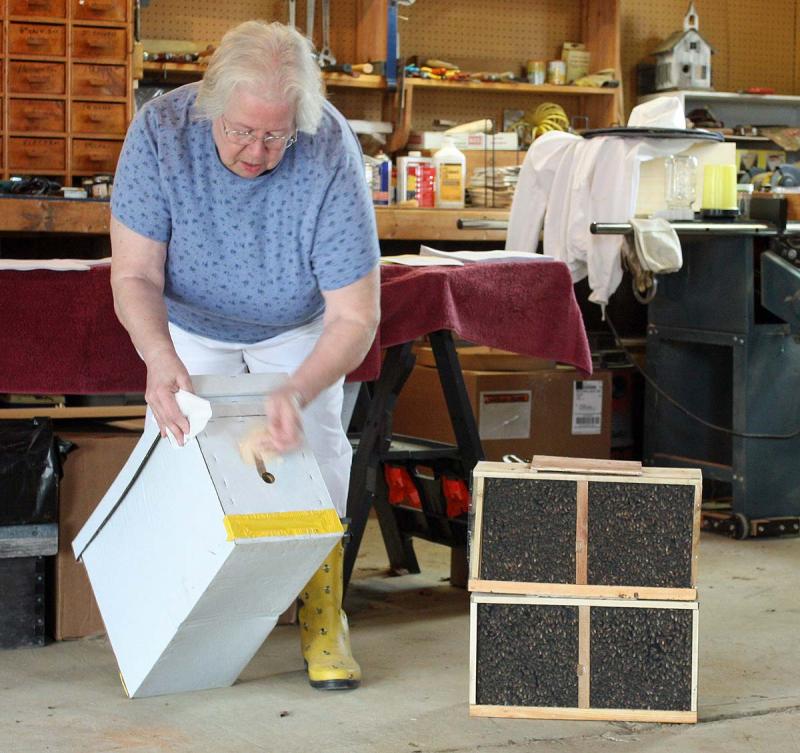 Jean Vose describes a nuclues of bees, left, and a package of bees, right. (Photo by Holly S. Edwards)
Jean Vose describes a nuclues of bees, left, and a package of bees, right. (Photo by Holly S. Edwards)
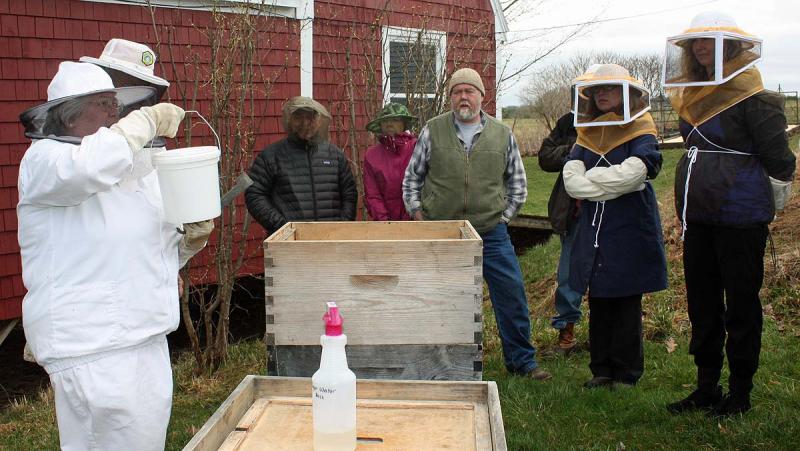 During a KLCBee Club hive installation April 20, Jean Vose shows everyone a feeder bucket filled with sugar water for the bees. (Photo by Holly S. Edwards)
During a KLCBee Club hive installation April 20, Jean Vose shows everyone a feeder bucket filled with sugar water for the bees. (Photo by Holly S. Edwards)
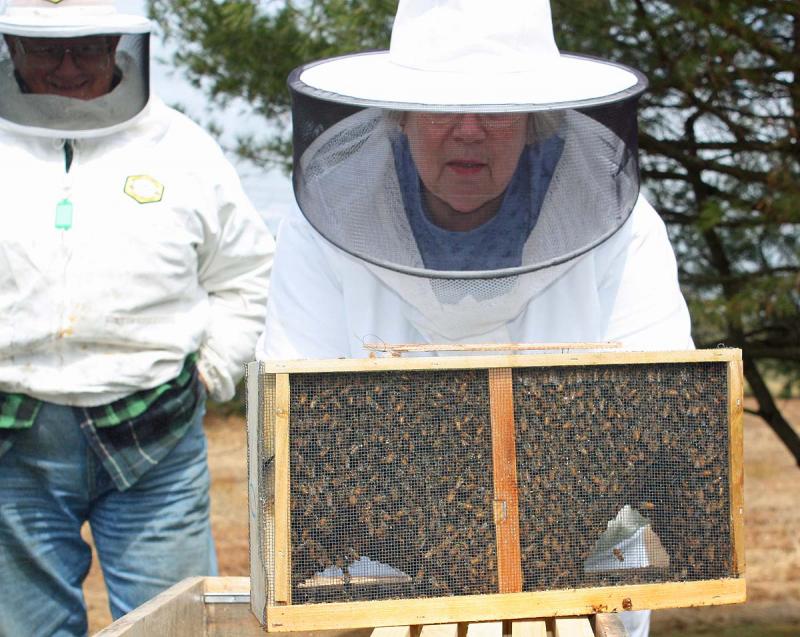 It was a bit cold for Saturday morning's beehive installation at Jean Vose's house, which worked to our advantage as the bees were calm and quiet and a cinch to work with. (Photo by Holly S. Edwards)
It was a bit cold for Saturday morning's beehive installation at Jean Vose's house, which worked to our advantage as the bees were calm and quiet and a cinch to work with. (Photo by Holly S. Edwards)
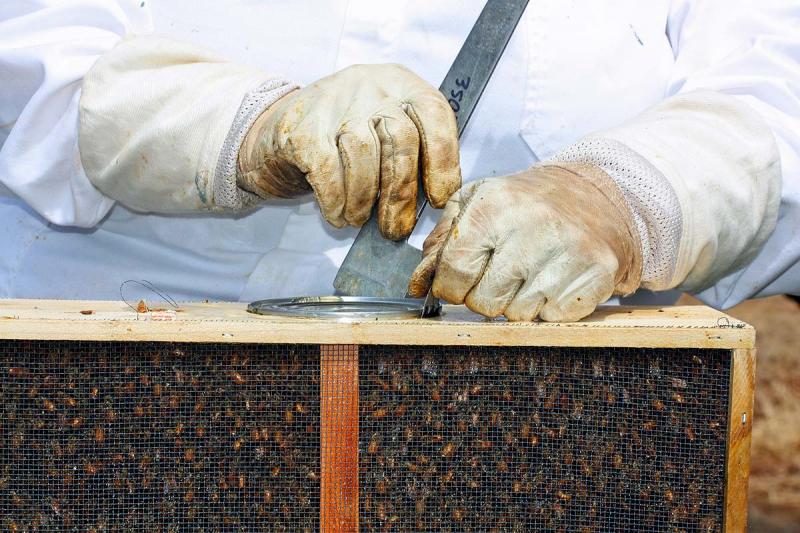 Prying the feeder can out of the package containing the bees can be a little tricky. (Photo by Holly S. Edwards)
Prying the feeder can out of the package containing the bees can be a little tricky. (Photo by Holly S. Edwards)
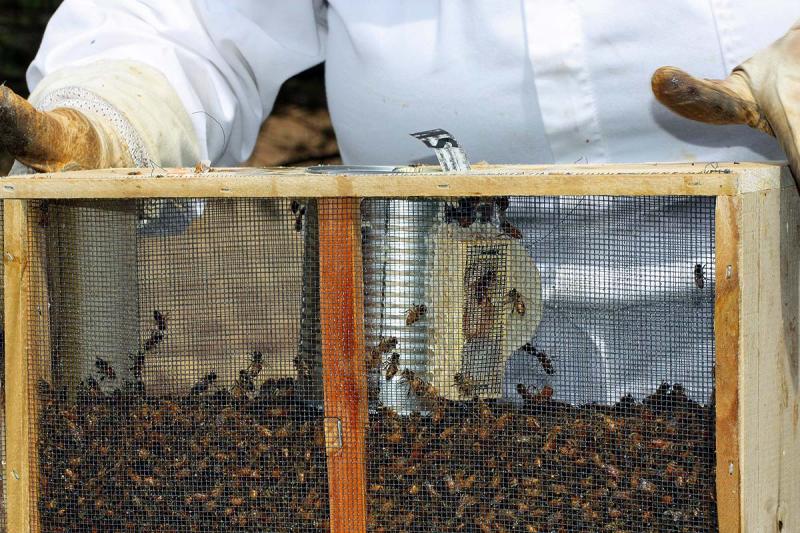 A tap of the package on the ground causes the bees to fall and exposes the feeding can and queen bee in her cage. (Photo by Holly S. Edwards)
A tap of the package on the ground causes the bees to fall and exposes the feeding can and queen bee in her cage. (Photo by Holly S. Edwards)
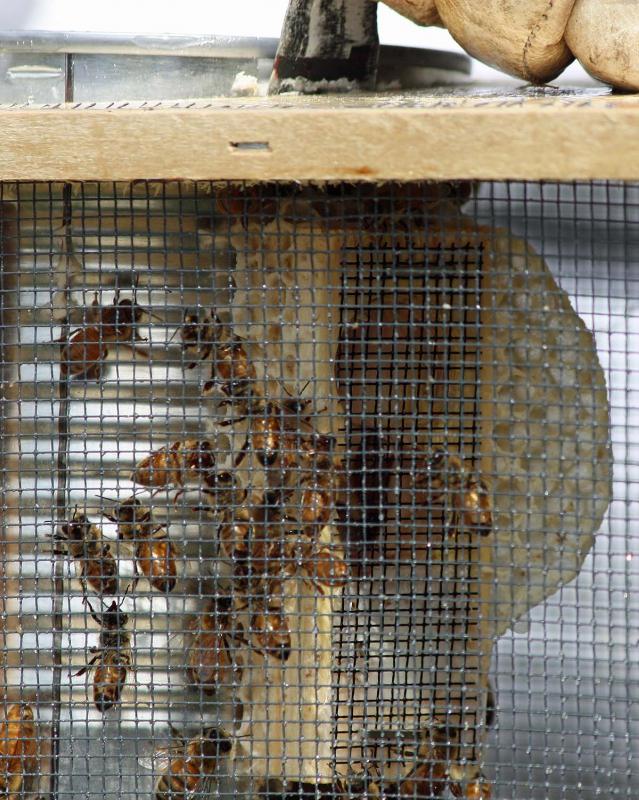 Having spent up to a week in the package, the bees have already begun to make comb around the queen. (Photo by Holly S. Edwards)
Having spent up to a week in the package, the bees have already begun to make comb around the queen. (Photo by Holly S. Edwards)
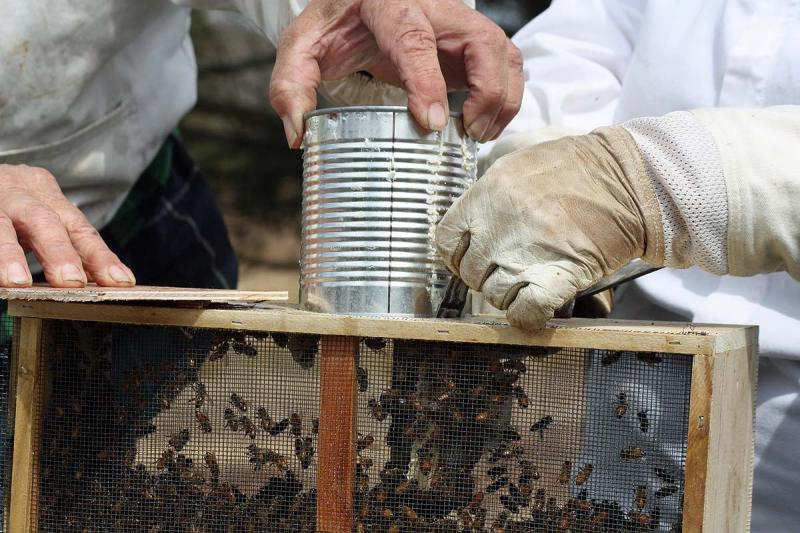 An extra pair of hands is helpful when working with a package of honeybees during the installation process. (Photo by Holly S. Edwards)
An extra pair of hands is helpful when working with a package of honeybees during the installation process. (Photo by Holly S. Edwards)
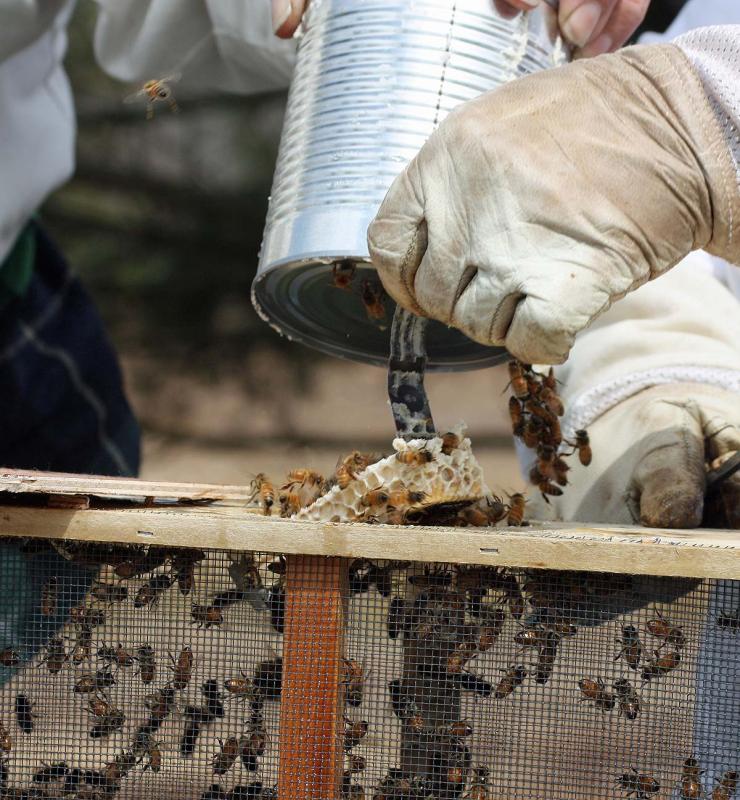 The queen honeybee in her cage is removed. (Photo by Holly S. Edwards)
The queen honeybee in her cage is removed. (Photo by Holly S. Edwards)
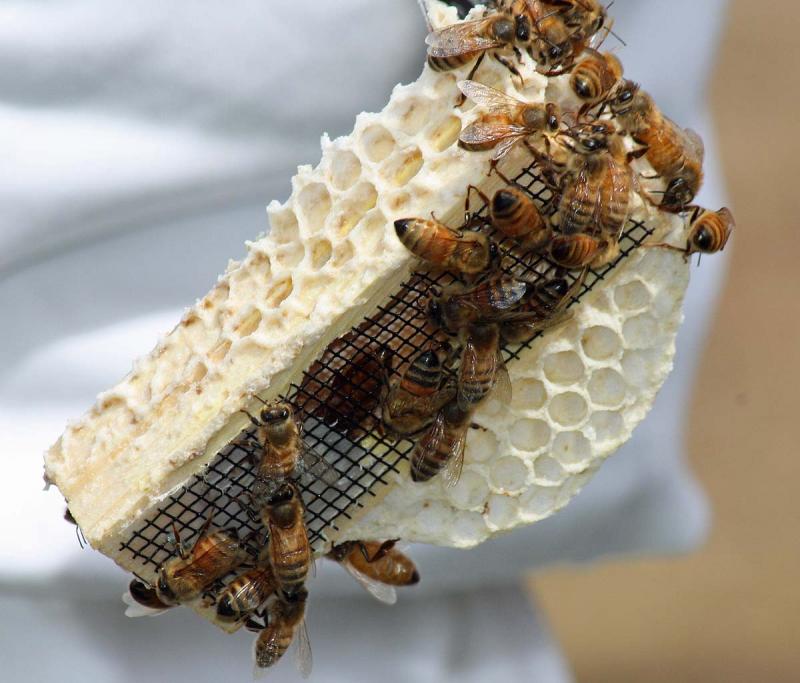 Worker bees cling to the queen's cage, as they have been tending her through the wire during transport. (Photo by Holly S. Edwards)
Worker bees cling to the queen's cage, as they have been tending her through the wire during transport. (Photo by Holly S. Edwards)
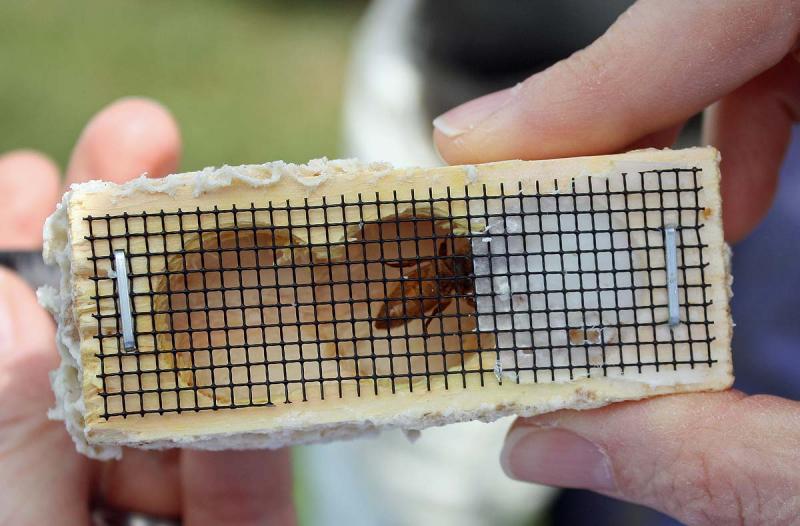 The queen bee travels in this cage, which is sealed at one end and has a removable cork at the other end. (Photo by Holly S. Edwards)
The queen bee travels in this cage, which is sealed at one end and has a removable cork at the other end. (Photo by Holly S. Edwards)
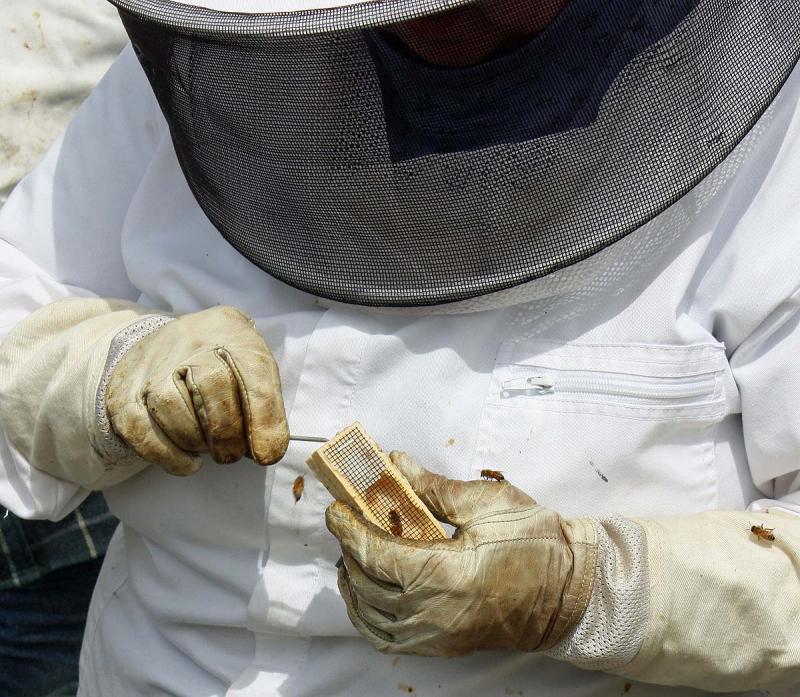 Behind the cork is another plug made of sugar candy from which the queen has been feeding. By poking a small hole through the candy, the workers will eat through the candy to release the queen inside the hive. (Photo by Holly S. Edwards)
Behind the cork is another plug made of sugar candy from which the queen has been feeding. By poking a small hole through the candy, the workers will eat through the candy to release the queen inside the hive. (Photo by Holly S. Edwards)
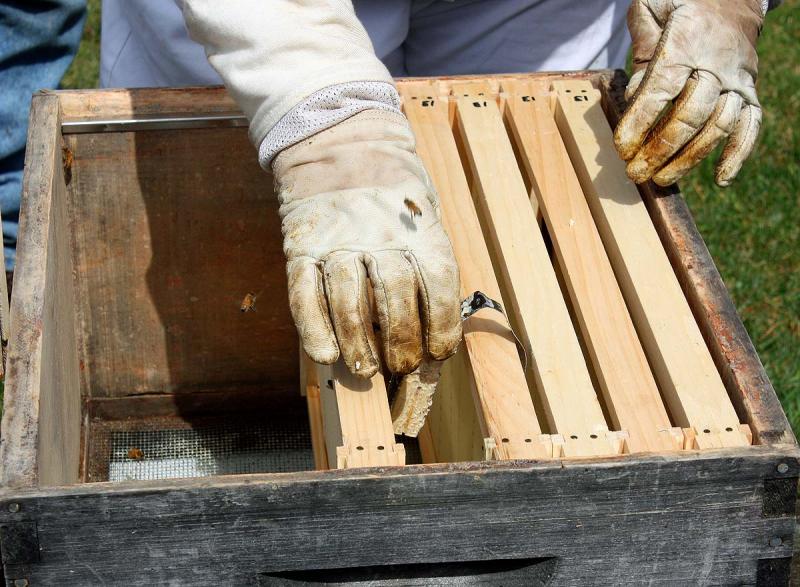 The queen in her cage is placed between to frames in the center of the hive. (Photo by Holly S. Edwards)
The queen in her cage is placed between to frames in the center of the hive. (Photo by Holly S. Edwards)
 The queen in her temporary cage are affixed in place with a thumbtack and eventually she will be freed by the worker bees. (Photo by Holly S. Edwards)
The queen in her temporary cage are affixed in place with a thumbtack and eventually she will be freed by the worker bees. (Photo by Holly S. Edwards)
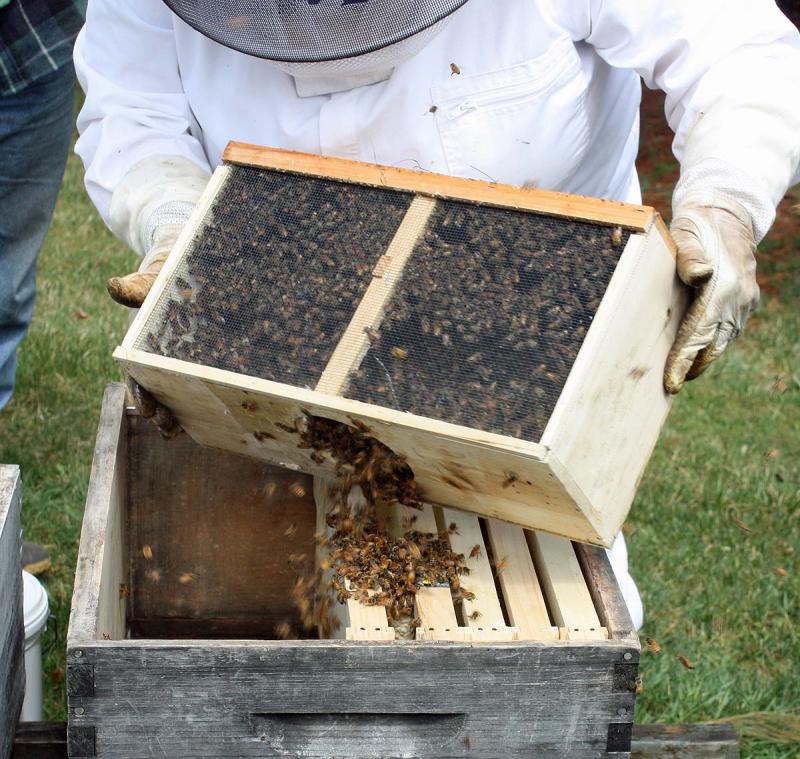 Removing the top from the package again, the bees are literally poured into the hive. (Photo by Holly S. Edwards)
Removing the top from the package again, the bees are literally poured into the hive. (Photo by Holly S. Edwards)
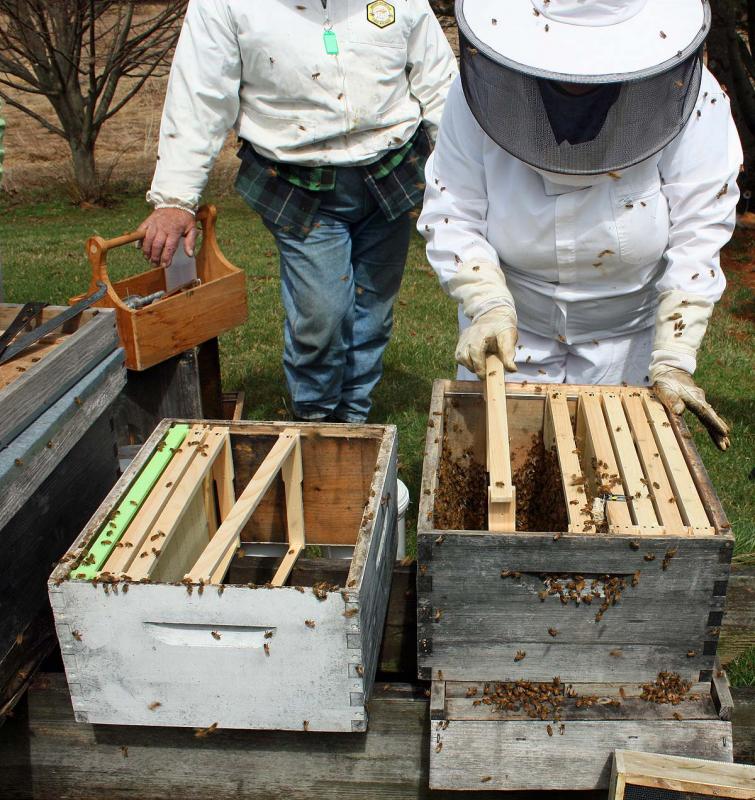 Using care not to squish bees, frames are put back into the hive. (Photo by Holly S. Edwards)
Using care not to squish bees, frames are put back into the hive. (Photo by Holly S. Edwards)
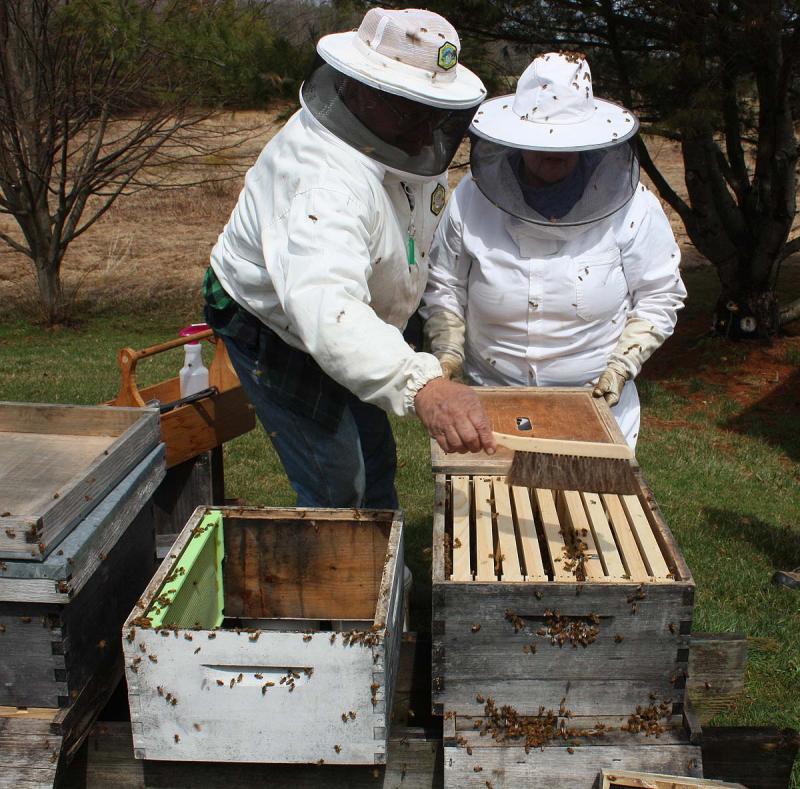 A soft bee brush is used to gentle move bees off the top so the inner cover can be placed over it. (Photo by Holly S. Edwards)
A soft bee brush is used to gentle move bees off the top so the inner cover can be placed over it. (Photo by Holly S. Edwards)
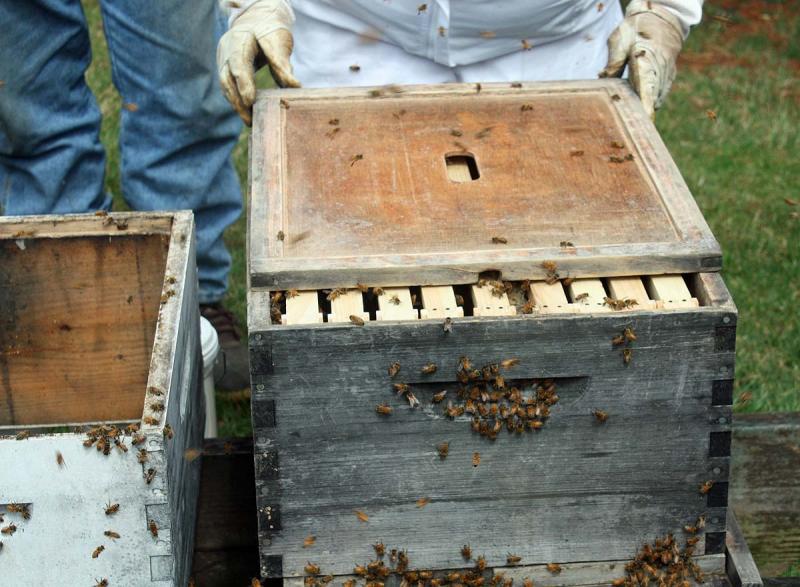 Atop this inner cover will go the white feeding bucket filled with sugar syrup for the bees to help them begin to build the honeycomb. (Photo by Holly S. Edwards)
Atop this inner cover will go the white feeding bucket filled with sugar syrup for the bees to help them begin to build the honeycomb. (Photo by Holly S. Edwards)
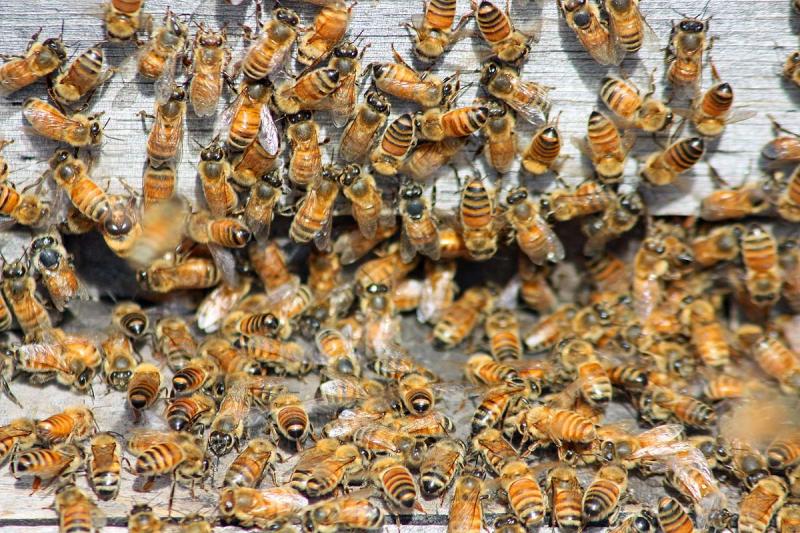 With 12,000 to 15,000 bees to go in the hive, those that were not poured in from the top congregate at the entrance to get in. (Photo by Holly S. Edwards)
With 12,000 to 15,000 bees to go in the hive, those that were not poured in from the top congregate at the entrance to get in. (Photo by Holly S. Edwards)
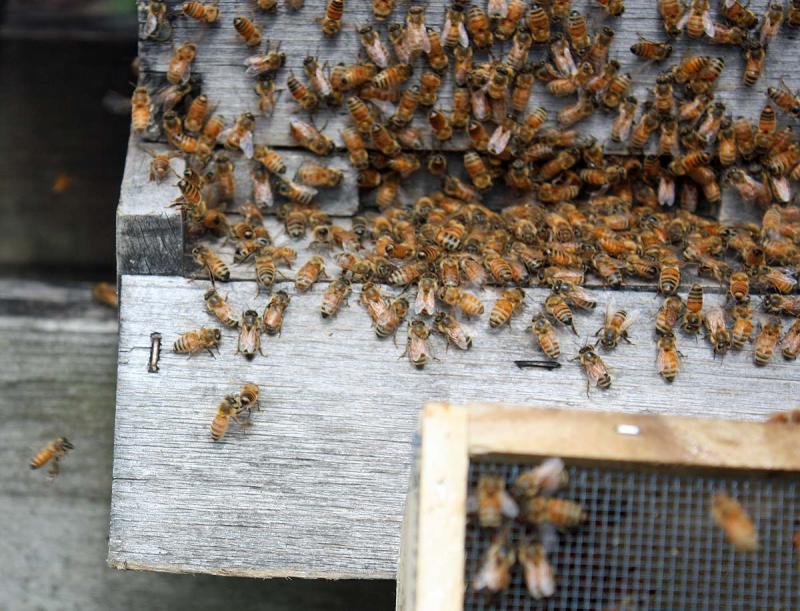 By placing the package outside the hive and at an angle, stragglers will eventually fly up and out of the opening, and into the hive with the others. (Photo by Holly S. Edwards)
By placing the package outside the hive and at an angle, stragglers will eventually fly up and out of the opening, and into the hive with the others. (Photo by Holly S. Edwards)
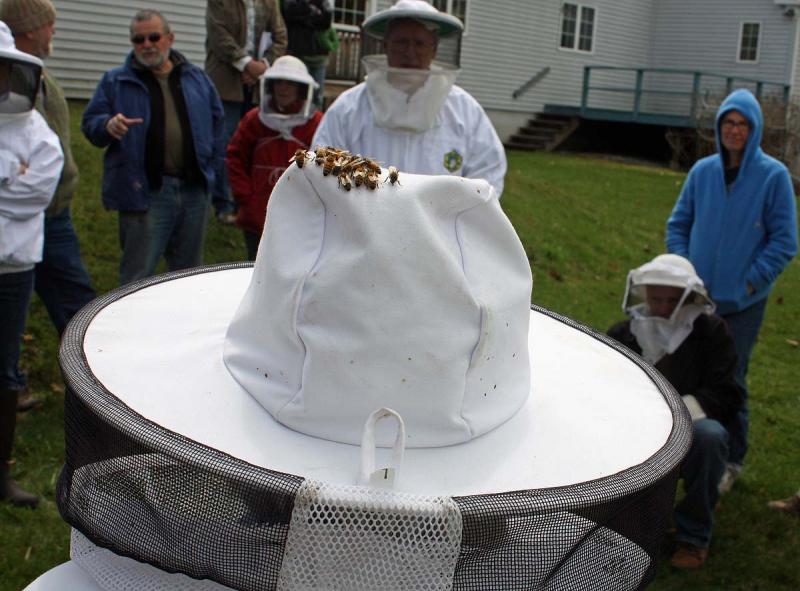 Bees gather on Jean Vose's hat and veil during Saturday's beehive installation. (Photo by Holly S. Edwards)
Bees gather on Jean Vose's hat and veil during Saturday's beehive installation. (Photo by Holly S. Edwards)
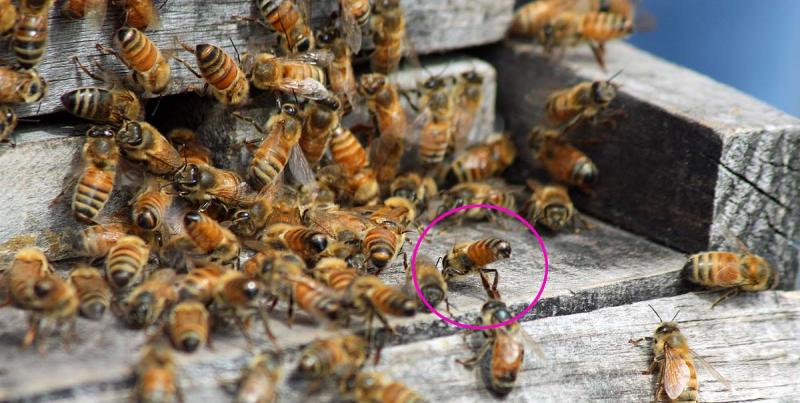 In this photo, the circled bee is fanning nasonov pheromone, telling the other bees, 'The queen is here in, this is our home, come quick and join the party.' (Photo by Holly S. Edwards)
In this photo, the circled bee is fanning nasonov pheromone, telling the other bees, 'The queen is here in, this is our home, come quick and join the party.' (Photo by Holly S. Edwards)
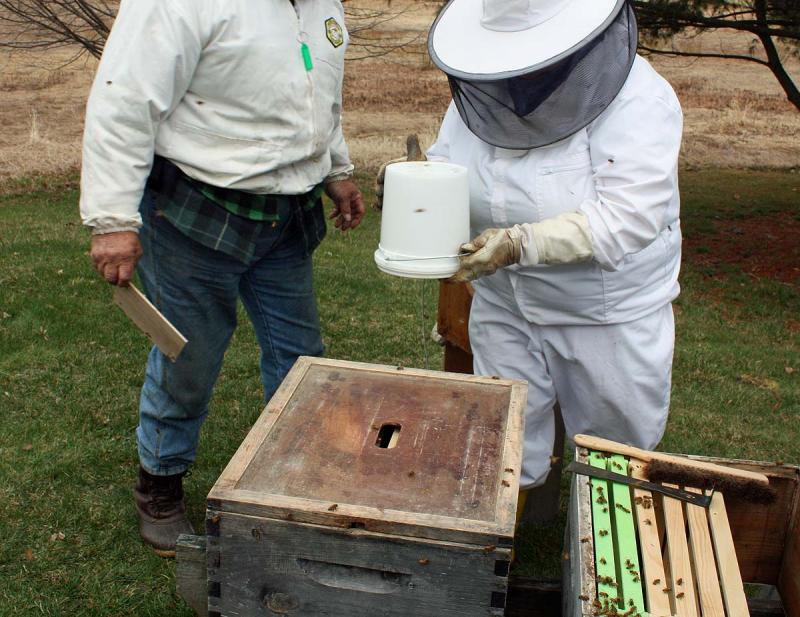 Adding the feeding bucket on top of the inner cover of the hive. (Photo by Holly S. Edwards)
Adding the feeding bucket on top of the inner cover of the hive. (Photo by Holly S. Edwards)
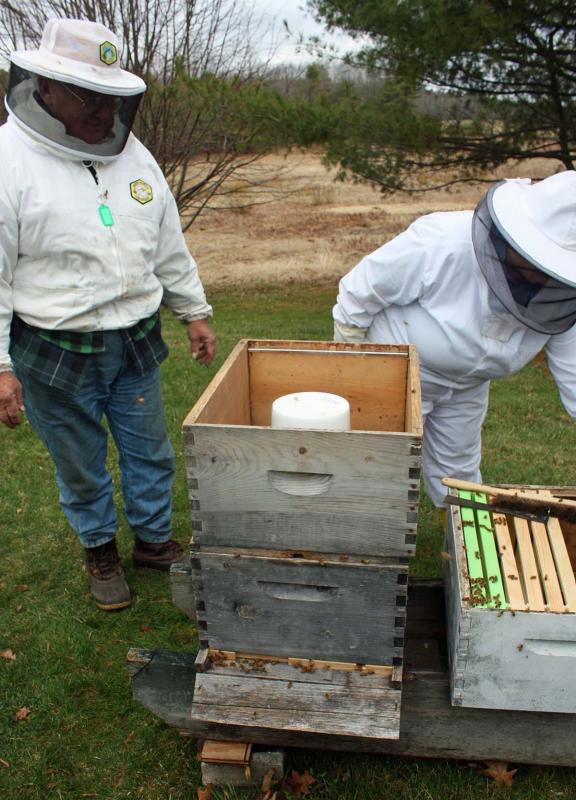 A medium box goes over the feeding bucket to protect it from the elements and keep the bees inside. (Photo by Holly S. Edwards)
A medium box goes over the feeding bucket to protect it from the elements and keep the bees inside. (Photo by Holly S. Edwards)
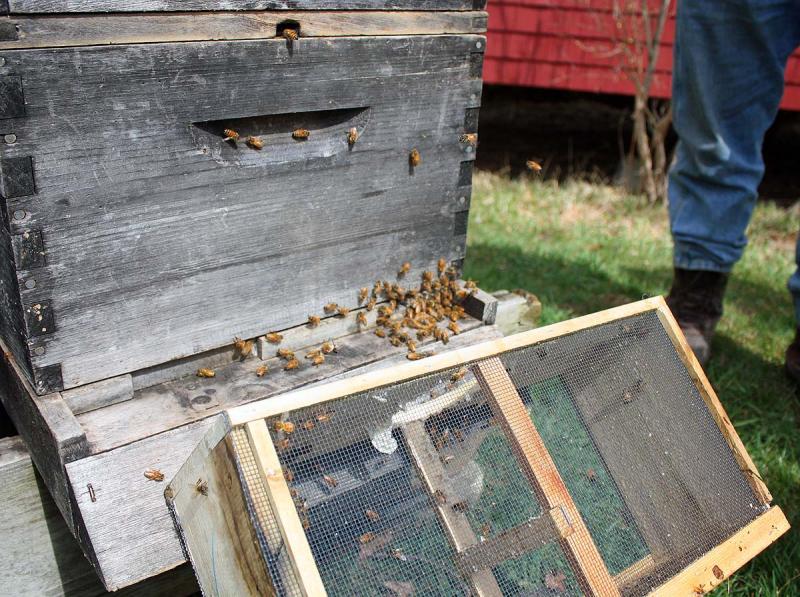 Nearly all the bees from the first package have found their way inside their new home in Nobleboro. (Photo by Holly S. Edwards)
Nearly all the bees from the first package have found their way inside their new home in Nobleboro. (Photo by Holly S. Edwards)
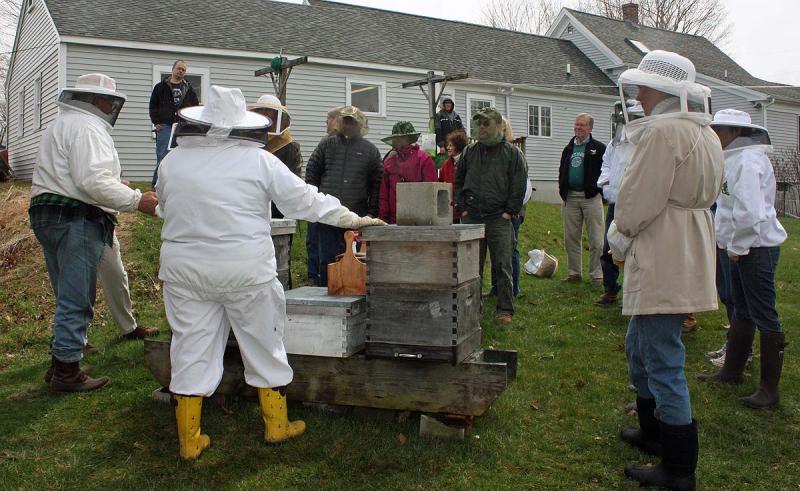 The group at Jean Vose's home in Nobleboro. This photo shows that beehives don't have to be far from a home to be safe for the occupants, the key is knowing your bees and how to work safely around them. (Photo by Holly S. Edwards) (Photo by Holly S. Edwards)
The group at Jean Vose's home in Nobleboro. This photo shows that beehives don't have to be far from a home to be safe for the occupants, the key is knowing your bees and how to work safely around them. (Photo by Holly S. Edwards) (Photo by Holly S. Edwards)
 Slow, steady wisps of smoke emanate from an adequately fueled and ignited beehive smoker during the first class of the 2013 Knox-Lincoln County Beekeepers club bee school March 5. (Photo by Holly S. Edwards)
Slow, steady wisps of smoke emanate from an adequately fueled and ignited beehive smoker during the first class of the 2013 Knox-Lincoln County Beekeepers club bee school March 5. (Photo by Holly S. Edwards)
 Jean Vose at the 2013 Bee School. (Photo by Holly S. Edwards)
Jean Vose at the 2013 Bee School. (Photo by Holly S. Edwards)
 Jean Vose and a smoker.
Jean Vose and a smoker.
 Jean Vose shows students a foundationless frame, on which honeybees will build the entire foundation of honeycomb with beeswax. (Photo by Holly S. Edwards)
Jean Vose shows students a foundationless frame, on which honeybees will build the entire foundation of honeycomb with beeswax. (Photo by Holly S. Edwards)
 Jean Vose displays a foundationless frame on which honeybees have drawn the comb from top to bottom. (Photo by Holly S. Edwards)
Jean Vose displays a foundationless frame on which honeybees have drawn the comb from top to bottom. (Photo by Holly S. Edwards)
 Peter Lammert shows what a hive box looks like with its 10 frames inside. (Photo by Holly S. Edwards)
Peter Lammert shows what a hive box looks like with its 10 frames inside. (Photo by Holly S. Edwards)
 Peter Lammert and a screen bottom board, though which detritus and mites fell down onto for disposal. (Photo by Holly S. Edwards)
Peter Lammert and a screen bottom board, though which detritus and mites fell down onto for disposal. (Photo by Holly S. Edwards)
 Peter Lammert stacks three medium hive boxes and shows how a tool can be used to pry apart frames stuck together by the bees with propolis. (Photo by Holly S. Edwards)
Peter Lammert stacks three medium hive boxes and shows how a tool can be used to pry apart frames stuck together by the bees with propolis. (Photo by Holly S. Edwards)
 Peter Lammert uses another tool to lift out frames. (Photo by Holly S. Edwards)
Peter Lammert uses another tool to lift out frames. (Photo by Holly S. Edwards)
 Peter Lammert with a beehive that's made of four mediums with an inner cover. One shallow box, called a honey super, is added when the rest of the hive is filled and that's the honey the beekeeper gets to keep. (Photo by Holly S. Edwards)
Peter Lammert with a beehive that's made of four mediums with an inner cover. One shallow box, called a honey super, is added when the rest of the hive is filled and that's the honey the beekeeper gets to keep. (Photo by Holly S. Edwards)
 Jane Dunston fills a smoker with tinder material, which can include pine needles, shavings, burlap and grass, among other things. (Photo by Holly S. Edwards)
Jane Dunston fills a smoker with tinder material, which can include pine needles, shavings, burlap and grass, among other things. (Photo by Holly S. Edwards)
 With some flame, it's time to jam more stuff on top so it smolders and smokes, not burns and flames. (Photo by Holly S. Edwards)
With some flame, it's time to jam more stuff on top so it smolders and smokes, not burns and flames. (Photo by Holly S. Edwards)
 A few puffs of the bellows and we have smoke. (Photo by Holly S. Edwards)
A few puffs of the bellows and we have smoke. (Photo by Holly S. Edwards)
 Proving to the students that it's important to make cool smoke, not hot smoke. (Photo by Holly S. Edwards)
Proving to the students that it's important to make cool smoke, not hot smoke. (Photo by Holly S. Edwards)
 A package of about 12,000-15,000 bees before installation at Jean Vose's beehives in Nobleboro April 20. (Photo by Holly S. Edwards)
A package of about 12,000-15,000 bees before installation at Jean Vose's beehives in Nobleboro April 20. (Photo by Holly S. Edwards)
 Jean Vose describes a nuclues of bees, left, and a package of bees, right. (Photo by Holly S. Edwards)
Jean Vose describes a nuclues of bees, left, and a package of bees, right. (Photo by Holly S. Edwards)
 During a KLCBee Club hive installation April 20, Jean Vose shows everyone a feeder bucket filled with sugar water for the bees. (Photo by Holly S. Edwards)
During a KLCBee Club hive installation April 20, Jean Vose shows everyone a feeder bucket filled with sugar water for the bees. (Photo by Holly S. Edwards)
 It was a bit cold for Saturday morning's beehive installation at Jean Vose's house, which worked to our advantage as the bees were calm and quiet and a cinch to work with. (Photo by Holly S. Edwards)
It was a bit cold for Saturday morning's beehive installation at Jean Vose's house, which worked to our advantage as the bees were calm and quiet and a cinch to work with. (Photo by Holly S. Edwards)
 Prying the feeder can out of the package containing the bees can be a little tricky. (Photo by Holly S. Edwards)
Prying the feeder can out of the package containing the bees can be a little tricky. (Photo by Holly S. Edwards)
 A tap of the package on the ground causes the bees to fall and exposes the feeding can and queen bee in her cage. (Photo by Holly S. Edwards)
A tap of the package on the ground causes the bees to fall and exposes the feeding can and queen bee in her cage. (Photo by Holly S. Edwards)
 Having spent up to a week in the package, the bees have already begun to make comb around the queen. (Photo by Holly S. Edwards)
Having spent up to a week in the package, the bees have already begun to make comb around the queen. (Photo by Holly S. Edwards)
 An extra pair of hands is helpful when working with a package of honeybees during the installation process. (Photo by Holly S. Edwards)
An extra pair of hands is helpful when working with a package of honeybees during the installation process. (Photo by Holly S. Edwards)
 The queen honeybee in her cage is removed. (Photo by Holly S. Edwards)
The queen honeybee in her cage is removed. (Photo by Holly S. Edwards)
 Worker bees cling to the queen's cage, as they have been tending her through the wire during transport. (Photo by Holly S. Edwards)
Worker bees cling to the queen's cage, as they have been tending her through the wire during transport. (Photo by Holly S. Edwards)
 The queen bee travels in this cage, which is sealed at one end and has a removable cork at the other end. (Photo by Holly S. Edwards)
The queen bee travels in this cage, which is sealed at one end and has a removable cork at the other end. (Photo by Holly S. Edwards)
 Behind the cork is another plug made of sugar candy from which the queen has been feeding. By poking a small hole through the candy, the workers will eat through the candy to release the queen inside the hive. (Photo by Holly S. Edwards)
Behind the cork is another plug made of sugar candy from which the queen has been feeding. By poking a small hole through the candy, the workers will eat through the candy to release the queen inside the hive. (Photo by Holly S. Edwards)
 The queen in her cage is placed between to frames in the center of the hive. (Photo by Holly S. Edwards)
The queen in her cage is placed between to frames in the center of the hive. (Photo by Holly S. Edwards)
 The queen in her temporary cage are affixed in place with a thumbtack and eventually she will be freed by the worker bees. (Photo by Holly S. Edwards)
The queen in her temporary cage are affixed in place with a thumbtack and eventually she will be freed by the worker bees. (Photo by Holly S. Edwards)
 Removing the top from the package again, the bees are literally poured into the hive. (Photo by Holly S. Edwards)
Removing the top from the package again, the bees are literally poured into the hive. (Photo by Holly S. Edwards)
 Using care not to squish bees, frames are put back into the hive. (Photo by Holly S. Edwards)
Using care not to squish bees, frames are put back into the hive. (Photo by Holly S. Edwards)
 A soft bee brush is used to gentle move bees off the top so the inner cover can be placed over it. (Photo by Holly S. Edwards)
A soft bee brush is used to gentle move bees off the top so the inner cover can be placed over it. (Photo by Holly S. Edwards)
 Atop this inner cover will go the white feeding bucket filled with sugar syrup for the bees to help them begin to build the honeycomb. (Photo by Holly S. Edwards)
Atop this inner cover will go the white feeding bucket filled with sugar syrup for the bees to help them begin to build the honeycomb. (Photo by Holly S. Edwards)
 With 12,000 to 15,000 bees to go in the hive, those that were not poured in from the top congregate at the entrance to get in. (Photo by Holly S. Edwards)
With 12,000 to 15,000 bees to go in the hive, those that were not poured in from the top congregate at the entrance to get in. (Photo by Holly S. Edwards)
 By placing the package outside the hive and at an angle, stragglers will eventually fly up and out of the opening, and into the hive with the others. (Photo by Holly S. Edwards)
By placing the package outside the hive and at an angle, stragglers will eventually fly up and out of the opening, and into the hive with the others. (Photo by Holly S. Edwards)
 Bees gather on Jean Vose's hat and veil during Saturday's beehive installation. (Photo by Holly S. Edwards)
Bees gather on Jean Vose's hat and veil during Saturday's beehive installation. (Photo by Holly S. Edwards)
 In this photo, the circled bee is fanning nasonov pheromone, telling the other bees, 'The queen is here in, this is our home, come quick and join the party.' (Photo by Holly S. Edwards)
In this photo, the circled bee is fanning nasonov pheromone, telling the other bees, 'The queen is here in, this is our home, come quick and join the party.' (Photo by Holly S. Edwards)
 Adding the feeding bucket on top of the inner cover of the hive. (Photo by Holly S. Edwards)
Adding the feeding bucket on top of the inner cover of the hive. (Photo by Holly S. Edwards)
 A medium box goes over the feeding bucket to protect it from the elements and keep the bees inside. (Photo by Holly S. Edwards)
A medium box goes over the feeding bucket to protect it from the elements and keep the bees inside. (Photo by Holly S. Edwards)
 Nearly all the bees from the first package have found their way inside their new home in Nobleboro. (Photo by Holly S. Edwards)
Nearly all the bees from the first package have found their way inside their new home in Nobleboro. (Photo by Holly S. Edwards)
 The group at Jean Vose's home in Nobleboro. This photo shows that beehives don't have to be far from a home to be safe for the occupants, the key is knowing your bees and how to work safely around them. (Photo by Holly S. Edwards) (Photo by Holly S. Edwards)
The group at Jean Vose's home in Nobleboro. This photo shows that beehives don't have to be far from a home to be safe for the occupants, the key is knowing your bees and how to work safely around them. (Photo by Holly S. Edwards) (Photo by Holly S. Edwards)
THOMASTON — April 16 was the last class for the nearly 50 students in the 2013 Bee School, and in the coming weeks, new colonies of honeybees will be arriving for many of them.
Six weeks of classes culminated in a hive installation in Nobleboro April 20, when nearly 30 people donned veils and watched as two packages of 15,000 bees each were introduced to their new homes.
Bee school began March 5 in Thomaston, and that first class was taught by Knox Lincoln County Beekeepers Club members Peter Lammert, Jean Vose and Jane Dunston.
The first class covered the parts and placement of a beehive, techniques and tips for opening and inspecting the hive and opinions on using wax foundation versus plastic foundation and going foundationless. There were also stations for watching a hive being stacked and put together, and for lighting a smoker and keeping cool smoke flowing.
During the six-week course, Lammert, Vose and Dunston covered everything new beekeepers need to know, and then some. There have also been guest speakers who have talked about bee biology and anatomy, hive dynamics, the difference between packages and nucleuses of bees, swarm control, and medicating and dealing with pests and diseases, among myriad topics.
As one of their students' who has since purchased two hives and is anxiously awaiting the call that our honeybees have arrived in Maine from Florida, I can honestly say six weeks is not nearly long enough to be assured of knowing everything.
But in another sense, we are ready to welcome the honeybees into their new homes in Camden and begin what will likely be an adventure in trial and error, encouraged by some prayers, good luck and help from a mentor. After all, what's the worst that can happen, right?
We know how to make smoke in the smoker, which should keep the honeybees calm. We have chosen a sunny, south-facing part of our fenced backyard backed by a row of wind-slowing cedars to site the hives. We have purchased a pair of EpiPens in case someone has an allergic reaction to a sting, whether it's from a honeybee or some other stinging insect in our yard.
In addition, we have assembled our hives and painted them to match the color of our house, assembled the frames on which the bees will build the comb to store honey and raise young, or brood, and we finished purchasing all the extraneous tools and various supplies we will need to safely and comfortably tend our bees.
What's left? We need to buy white and powdered sugar in bulk and we need to move the hives outside into the yard. We learned in class that when our bees arrive, they will be hungry. There are few things yet blooming, so the bees won't be able to find much out there in the world to feed on so they'll depend on us to feed them sugar water. It is actually a rite of spring beekeeping, feeding sugarwater.
We purchased a nucleus of bees, as opposed to a package, because a nucleus is akin to a mini-hive when it arrives. It has a queen, and a range of ages of bees. The frame that they will come with will likely be old and dirty, so we will encourage them to immediately begin building comb on our new frames.
If you have never smelled melted beeswax, you've missed a glorious aroma. Sunday we spent an hour rolling a thin coat of melted beeswax on our new plastic frames, to give the bees a little head start in their work. And those wax-coated frames sitting in the back room have created a heavenly scent that my husband would like to spread all over the house.
During the waxing process yesterday, a lone honeybee flew onto the deck and landed on the worktable, obviously drawn by the smell too. It was fun to know that we were being visited by a honeybee, and we took it as a sign of encouragement that what we were doing would soon be appreciated by a plethora of neighboring plants and tiny creatures.
Mid-May, we will get the call from the honeybee supplier we chose that our two nucleuses of bees are ready for pickup. We will drive early in the morning to Windsor with two boxes from our hives and the beekeeper there will transfer five bee-covered frames into them. On those frames will be an active and established queen, workers (females) and drones (males) and hopefully some brood in various stages of development.
As we close the tailgate of the truck and drive away, we'll officially be beekeepers. Gulp.
At the second class, KLCB club member Adam DeMerchant explained the difference between "nucs" and "packages," which are how new honeybees are delivered to beekeepers.
Packages of bees are available in two-, three-, four- and five-pound units, with approximately 2,500 bees per pound. An average three-pound package of honeybees contains between 10,000 and 12,000 bees, maybe more, and one queen. Bee packages can be sent through the mail, as well as shipped in container trucks and picked up from the purveyor.
The advantages of obtaining packages of bees are that it's easier for a beginner to work with because there are fewer bees than in an established hive; there are more adult bees; there are generally no brood diseases (because there are no brood yet); and replacements are easy to obtain. Disadvantages include ending up with an injured queen as a result of stress during shipping; bee drifting is common during installation into the new hive; there are no eggs or brood until the queen starts to lay so it takes about 21 days for new adult workers to emerge; and these bees will need to be fed heavily to encourage them to draw out the foundation on which brood develop and honey is stored.
The nucleus comes complete with frames inside a box, which can be either disposable or reusable. The nuc hive includes all ages of bees and brood when purchased during the spring and summer months and has been prepared and cared for by an experienced owner who is usually available for questions and issues later on. These are all advantages of a nuc hive. Another advantage is that starting with an established hive, surplus honey (for human consumption) at the close of the honeybee season is almost guaranteed.
The downsides to obtaining honeybees via a nuc hive are that old equipment can harbor disease and the combs could be so old that they immediately need replacing. The honey already in production could be diseased and larger established colonies can be more difficult for the beginner to work with.
In both packages and nucs, the bees may be infested with mites that will require immediate intervention to help stave off destruction of the entire colony. That's where the bulk powdered sugar comes in, for those that choose to go natural over medications at the outset. Dusting your honeybees with powdered sugar causes the mites to fall off the bees and land down at the bottom of the hive, where they are removed by the beekeeper.
These are some of the first hits of information the class learned about, and there were four more classes to go and a lot more new terms and tips and procedures to learn about and understand.
If this class has taught the students anything, it's that many parts of beekeeping are open to trial, error and whimsy. For every beekeeper that has a tool they can't live without, there are two more that swear by another kind of tool. And when it comes to the hives themselves, they can be made taller or shorter to suit the beekeeper's physical needs, while the methods of feeding the bees are also up for debate.
The beehive installation April 20 at Jean Vose's home in Nobleboro was really interesting, especially for novice beekeepers like us. Vose installed packages into her two hives, and it was helpful to watch her go through the steps with live bees. If anyone had any fear, this was a great time to either confirm it or realize there was little to fear when the proper safety measures were taken into account.
In addition, choosing the right day and time, having the benefit of cooperative weather and another pair (or 20) of helpful hands all helped make Vose's installation go smooth.
If you happen to see a small bodied, brown or yellow four-winged bee in your yard, it's likely a honeybee. Rest assured it is very busy doing its job and wants to be left alone. If you have a bird bath or other small water source in your yard, be sure and put a sponge or a few rocks in it to help keep thirsty bees from drowning.
For those interested in planting for honeybees, bear in mind that pollinators are creatures of efficiency and prefer patches of the same flower over single specimens. According to the Maine Cooperative Extension, bees favor purple, blue and yellow flowers planted in masses, to get their attention. Spring and fall can be challenging times for honeybees, as they are hard at work in the former preparing for the latter by building up comb, tending brood to populate the hive with new bees and stock up on food (honey) to overwinter.
In the spring, leave the dandelions in your lawn a little longer for the honeybees. In the fall, don't be quick to clip withering flowers, because they can still harbor nectar and pollen the bees need.
Favored plants for bees in April and May include the red maple tree, shadbush (tree and shrub), crocus, heath, snowdrop, apple trees, daffodils, pieris, plum and cherry trees, red oaks, willow trees, dandelion, tulip, blueberry shrub and Johnny jump-up.
June to August, favored annuals include anise hyssop and borage, while perennials include chives, purple cornflower, St. John's wort, bee balm, oregano, self-heal, lamb's ear, dandelion, thyme (creeping) and red clover. For shrubs, try sheep laurel, and roses, as well as evening primrose, a biennial.
Late season bloomers include the aster, autumn dandelion (annual), goldenrod, meadowsweet shrub and dandelion (perennial).
For more information about the Knox Lincoln County Beekeepers Club visit www.klcbee.com
———————————————————————————
Editorial Director Holly S. Edwards can be reached by email at hollyedwards@penbaypilot.com or by calling 207-706-6655.
Event Date
Address
United States









































































































